Introduction
With the advent of IoT (Internet of Things), Big Data is being generated by billions of household devices, industrial machines, and their processes, and products and people moving through supply chains via transportation and logistical entry and exit points. Everyone is now connected with everything, everywhere and at all times generating an enormous amount of data every second. Management of business processes now requires an ability to understand this big data, and through it understand consumer behavior, organizational behavior and emerging trends of business interactions. Semantic technologies include ontological representations that help in deriving meaning from big data through the use of data and business analytic tools (Le-Phuoc et al., 2016).
The use of ontology and other related knowledge representations have also become indispensable tools for storing, and managing of huge amount of research data. This research data not only contain datasets and repositories of research papers, but also include theoretical models and conceptual frameworks that are driving the generation of data in various fields such as medical sciences, social networks, Wikipedia-like knowledge bases, and enterprise applications. Given the explosion of research articles in medical and cognitive sciences “The National Centre for Biomedical Ontology” develops biomedical ontology that delivers tools for accessing and unifying large biomedical data sets and data that are semantically interoperable and they enable predictable, meaningful, computation across knowledge sources developed independently to meet diverse needs (Rubin et al., 2006). Another example is the development of Cognitive Paradigm Ontology (CogPo) that integrates various ontologies of cognitive psychology to provide a robust indexing technology as a theoretical framework to index neuroscience and psychology scientific data in large databases (Turner and Laird, 2012).
Such integrated taxonomies and ontologies that are available in medical sciences research are missing in business management research. This research develops a repository of conceptual frameworks that allows researchers to quickly access business management research and also facilitates exploring the constructs and their relationships. The ontological representations captured by this repository conceptualize various domains of interest in a manner that allows multiple ways to model, analyze and reason upon the domains. This provides opportunities to social scientist to explore new dimensions in business research. It also enables development of datasets and their integration and exploration through business analytics and advanced query tools such as DL queries.
The paper describes the development of ontological representations of conceptual frameworks found in research literature from the fields of Human Resource Management, Marketing, Consumer Behaviour, Finance, and Health Management. Specifically, conceptual frameworks of research papers from fields such as e-Loyalty, strategy education using off-the-shelf computer games, insurance, consumer animosity, servant leadership, online shopping, work life balance and customer purchasing behavior were captured using the Protégé software tool. Around 15-20 research papers from each one of these fields were chosen to explore coverage of a wide variety of conceptual models.
The repository helps in the integration of behavioral and social variables and their relationships that are available in isolated research papers but have not yet been electronically captured and integrated. The ontology based repository aids in conducting systematic literature reviews and helps in the identification of new research constructs and facilitates the identification of gaps where relationships tested in one field of research have not been studied or explored in other fields.
An Introductory Example of Integrating Conceptual Frameworks
When conceptual frameworks from hundreds and thousands of research papers are integrated, the resulting constructs and their relationships require special search and viewing tools. The following simplified example provides an intuitive visual understanding of how the process of integrating conceptual frameworks begins. The example picks three papers from management field with some common variables.
Table 1: Example of the variables used in three studies
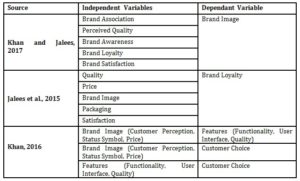
Table 1 shows the variable used in three studies. First study describe the effect of five independent variables i.e. “Brand Association”, “Perceived Quality”, “Brand Awareness”, “Brand Loyalty”, and “Brand Satisfaction” on the dependant variable i.e. “Brand Image”(Khan and Jalees, 2017). The second study describe the effect of independent variables like “Brand Image”, “Packaging”, “Satisfaction”, “Price”, “Quality” on the dependant variable i.e. “Brand Loyalty” (Jalees et al., 2015). Third study describe that independent variables i.e. “Brand Image (Consumer Perception, Status Symbol, and Price)” and “Features (Functionality, user Interface, and Quality)” impacts “Consumer Choice”, whereas “Feature” is also acting as a mediating variable (Khan, 2016). The conceptual frameworks from these three papers are shown integrated in Figure 1 using a simplified set union.
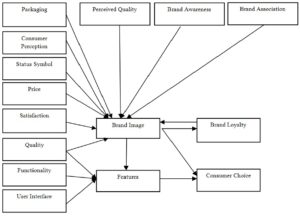
Fig 1: Integration of three studies shown in Table 1; “Brand Association”, “Brand Awareness”, “Perceived Quality”, “Packaging”, “Consumer Perception”, “Status Symbol”, “Price”, “Satisfaction”, and “Quality” impacts on “Brand Image” which further impacts “Brand Loyalty” and “Consumer Choice”. “Furthermore”, “Quality”, “Functionality” and “User Interface” impacts “Features”, and “Features” further mediate “Consumer Choice”.
Please note that the simplified example in Figure 1 highlights the integration of only three conceptual frameworks and is for illustration purposes only. This figure does not include other relationships that were built in to the ontology such as the links to the publications, to the authors, to the instruments and their references, and other annotations that describe the relationships. Also, note that the process of ontology development using the tool Protégé requires entry of conceptual frameworks and their variables from one field, followed entry of conceptual frameworks from other fields. The repository eventually will have thousands of conceptual frameworks integrated with each other that would enable a researcher to search for any relationship on a given set of variables.
Related Work
Taxonomy helps in organizing the data but cannot display variables that fall under various categories and different fields and different contexts. Ontology widens the scope of taxonomical data for organizing the information. Unlike a taxonomy which only enables keyword based searches, an ontology enables data retrieval using sophisticated query languages and tools that select on the basis of different parameters and their values, and on different relationships, and can, thus give more precise results (Mikhalenko, 2003).
The use of ontology for making sense of the data and its conceptual models is widespread across several disciplines because a domain ontology is a reusable vocabulary of the concepts and their relationships within a domain and because it helps in describing the activities taking place in that domain, and linking them to the theories and elementary principles governing that domain. (Pérez et al., 2004). Knowledge representation tools such as Protégé are typically used for developing ontologies that exist in IT, MIS, ERPs, medical research libraries, cognitive sciences repositories, social networks (e.g. Facebook), search engines and business process modeling.
Value proposition of hugely successful Internet companies is based upon ontology like representations. These include social networking companies like Facebook, Twitter, and Google and even B2B companies like Amazon and AliBaba. Their business depends upon making sense of the massive amount of data that is being generated through transactions, posts, tweets, images, videos, and feelings, which are exchanged by millions and shared with millions. This data can only be explored by specialized data analytics tools that use ontology to understand the demographic and psychographic profiles of people and their interactions. For example, Facebook is using FOAF ontology and graph database to represent its semantic information (Rowe and Ciravegna, 2008). The software developed for Twitter, FlickR, and Facebook enables extraction of ontologies in RDF formats. Voice agents like Apple Siri and Amazon Alexa also extend their services using ontology based technologies (Hwang et al., 2016).
Wikipedia is increasingly formalizing the relationships embedded in its articles in the form of links to texts, images, templates, categories and subcategories, keywords and external web pages and resources. Wikipedia information is not only manually or visually accessible but is allowing integration with other systems using ontology based representations and APIs that can automatically retrieve useful information through “semantic” searches. The DBpedia is an open source project that converts the massive amount of textual information in Wikipedia into ontology based representations that enable extraction of interesting information through automated queries. Multi-Lingual information can be extracted from its knowledge base using the W3C-recommended ontology based technologies (Grefenstette and Rafes, 2015); Mendes et al. (2012).
Ontology based systems are helping analyze B2B services such as those offered by Ali Baba and banking systems in the service industry. Conceptual models that capture the factors important in value creation in B2B context create value by linking to web resources of case studies, press releases, product offering, internal product briefing, corporate procedures and white papers. Indexing of such resources and their attributes using ontologies facilitate retrieval (Oberle, 2014). Ontologies have also been used in describing, designing and linking the business processes to improve their productivity (Belhajjame and Brambilla, 2009). For example, syntactical and structural information can act as an input for ontology-based specification of business processes and for encoding information in the form of annotations to “semantically” described business processes.
Ontology and other knowledge representations are used in the design, development and knowledge acquisition through software for business information systems and enterprises applications, typically, from computer science point of view. Hinkelmann et al. (2016); Osterwalder et al. (2005); Osterwalder (2004); Oberle (2014). For example, Customer Relationship Management (CRM) interactions and behaviors are represented using ontology for information sharing and decision making using artificial intelligence (Liwen and Min (2004). Analysis of the text of complaints from customers using ontology can explain the customer behavior by linking the antecedent conditions for customer’s loyalty and disloyalty (Kasnakoglu et al., 2016). Similarly, development of ontology helped in the design of a Personalized Target Advertisement (PTA) system (Kim and Kang, 2013).
Researchers in the medical sciences areas such as biology, biotechnology, neuroscience, biochemical, and genes databases have benefited extensively from ontological and related knowledge representations that help in creating datasets and research repositories to electronically store, integrate, share and access research results (Soldatova and King, 2005). PubMed and related projects have developed a huge repository of extensive biomedical literature using ontology (Vanteru et al., 2008). These projects use ontology based representations that enable extraction of interesting patterns from massive datasets of genes, proteins, and related molecules using “semantic” technologies (Bandrowski et al., 2016). Cognitive neuroscience is another area which uses ontological representations and knowledge management techniques to help in identifying and developing the structure of cognitive processes. Several web applications like PubAtlas, PubGraph and PubBrain are available to examine and visualize the cognitive concepts (Bilder et al., 2009; Antezana et al., 2009). Cognitive Atlas Project provides ontological representations of mappings of brain functions and mental processing. Development of bio-sciences representations of research concepts and data is then a team effort involving researchers with the background in philosophy and computer science in addition to the domain experts from biology (Antezana et al., 2009).
Gap Identification
The review of the above literature indicates that even though ontology based systems are being extensively used in various disciplines, however business management “research” has not taken advantage of the ontology based representations and their power in helping the researchers. Business management research is a relatively untouched domain for ontology experts to link their research datasets, theoretical models and conceptual frameworks. There is a need for integrating the results of research of business and social phenomena involving behavioral and cognitive variables and their relationships through ontology based repositories.
This paper focuses on the need to employ the strengths of ontological representations in capturing and retrieving conceptual framework defined in quantitative research in the field of business and management science.
Methodology
The ontology of business management research literature described in this paper has been developed using the methodology for developing semantic ontological structure (Yadav et al., 2016); Yan and Zha (2010); Wand et al. (1999) and consisted of the following steps:
- Defining the objective of the development of ontology for the domain of business management research
- Identifying the challenges of ontology development in the domain
- Defining domain and scope of ontology development
- Developing a comprehensive taxonomy
- Building classes and hierarchy.
- Determining slot/properties of the classes.
- Developing ontology and seeing how the ontology works.
The ontology representations of conceptual frameworks have been developed using the open source software tool Protégé 5. Protégé software is user- friendly and supports visualization plug-ins which helps in the visual and abstract understanding of the ontology. It works using a language called Ontology Web Language (OWL). Ontology development requires both domain knowledge (i.e. competency to gauge the construct of business management) and tool expertise (using a software tool like Protégé 5.0). The research group working on this project has members who have expertise in computer science as well as business management.
The application of the above methodology resulted in an ontology based repository that consisted of the following elements (Wand et al., 1999). The details of these elements are given in the next section.
- Classes or Concepts: Ontology is a formal explicit description of concepts in a domain. For example, Figure 5 shows the concepts from the transport domain where “vehicle”, “car”, “bus”, and “route” are classes or concepts. Classes in the management research domain include “construct”, “variable”, types of variables, types of relationships, “instrument”, “publication”, citations, etc.

Fig 2: Classes, Super Classes, Sub classes, Instances and relationships in the transport domain
- Super-classes and Sub-classes: Once the key concepts are identified in taxonomy then these are organized in a hierarchical structure where Subclasses are concepts which are more specific than their super class. A class can be further generalized into a Super Class. Or a class may be specialized into Sub-Classes. This creates a hierarchy of concepts. For example, in the transport domain, “Vehicle” is a more generalized class than “Bus”. And a “Car” is more specific than “Vehicle” class. Thus, “Car” and “Bus” are subclasses of the super class “Vehicle”. Instances or objects are also sub-classes representing individual and concrete data entities. Instances are the objects of subclasses representing an individual with unique data properties like name, title and other values. In Fig 2, there is an instance of Toyota Corolla having different data properties like Model, Color and Licence number plate.
- Relationships between Classes and Instances: Properties/Slots are relationships between classes and their objects/instances. There are two kinds of properties Object Properties and Data Properties.
- Data Properties are used for storing the data with each object/instance (Wand et al., 1999); Yadav et al. (2016). For example, in the transport domain example in Figure 2, a specific instance of a car is identified by its license plate number, color, model etc. This specific instance is recognized by the registration book of the car. In our management research domain, data properties of a class such as a “Publication” would include attributes such as the Year of publication, Volume number, Issue number, Title of the paper etc. The specific instance of a publication is recognized in the research literature as a particular citation.
- Object Properties (owl: ObjectProperty) connect one class to another (Pérez et al., 2004) and are identified as relationships between classes. In the transport domain, relationship between a “Bus” class and a “Route” class is that a bus is associated with a particular route. In the business research domain, relationships between constructs are identified as causal relationship, moderating relationship or a mediating
- Restrictions on Slots: Role restrictions describe the restrictions imposed on each property and constrain the values that can be assumed by that property. For example, a Publication has only one Title but can have one or more authors.
- Knowledge Base is an ontology model and a populated set of individual instances of classes connected with hierarchical relationships as explained above and with specified relationships between classes and their instance. DL (Description Logic) queries are a formalism to extract knowledge logically. OWL ontology gives precise meaning to a description. It also enables reasoning algorithms to answer complex and simple queries about the domain (Iqbal, 2012).
The knowledge base produced by this research consists of an integrated repository of conceptual frameworks containing 680 individuals representing the 351 classes. These individuals are connected with their specified relationships using Object Properties.
Findings and Discussion
This section describes the findings as per the specified steps of the selected methodology; Wand et al. (1999); Yadav et al. (2016) for developing the ontology based repository of business management research.
Objectives of Business Management Research Ontology
Construction of an ontology starts with the specification of the objectives (Wand et al., 1999). The following objectives were identified for creating business management research ontology:
- Ease of reuse of domain knowledge of business management research.
- Ability to validate assumptions used in business management research.
- Separation of domain knowledge from the operational knowledge of business management.
- Ability to identify constructs used in one research field but not used in another research field.
- Identifying research gaps.
- Exploring relationships tested in one context but not tested in others.
- Types of tests used to validate different relationships.
Challenges In The Development Of Ontology
Training a business researcher in using a tool for developing ontology such as Protégé was a challenge for several reasons: A business researcher often finds difficult the terminologies of ontology obtained from the knowledge representation discipline of computer science. There is a steep learning curve and requires practice with a tool before a researcher becomes comfortable with the concepts. Business researchers understand quantitative conceptual frameworks but require training in technical skills to learn a software tools like Protégé for knowledge representation.
A typical conceptual framework contains only a few concepts and few relationships and is easy to comprehend and visualize in a single diagram. Our integrated ontology in Protégé, however, contains thousands of concepts and relationships that are difficult to comprehend and visualize without specialized tools. Protégé provides specialized features for analyzing the numerous relationships of concepts in multiple dimensions and across multiple relationships. These features enable the user to concentrate on relationships and gaps even when there is a large number of concepts and their relationships which cannot be analyzed visually or manually. It is often a challenge to learn features such as the query tool in Protégé to explore the relationships and identify the gaps.
These challenges were overcome as follows: A business researcher (domain expert) in team was trained on protégé software by another business researcher with computer science background (tool expert). During the pilot phase, a set of conceptual frameworks were chosen for converting into the ontology. This pilot phase enabled the development of a four step training manual to help business researchers learn the use of protégé software for creating ontological representations of conceptual frameworks. This phase also trained the experts in analyzing the ontological representations of different types of relationships and discovery of some fundamental classes. During the next phase, a set of Ph.D scholars analyzing conceptual frameworks of their selected area of research were asked to represent as ontology the conceptual frameworks of the research papers that they were surveying. To meet this challenge, cellfie plugin was explored and an excel sheet with predefined format was developed and shared with the researchers. The template excel sheet facilitated for the scholars putting the constructs and their relationships in a format that could then be imported in the tool.
Domain and Scope of Ontology – Business Management Research
The scope of this ontology relates to capturing and integrating conceptual frameworks in the area of business management research. Quantitative research articles were chosen for systematic literature review and gaps were identified about the use of constructs and their relationships.
Development of Taxonomy
The development of domain ontology started with the building of a comprehensive taxonomy of concepts and their relationships. The taxonomy tabulated the constructs and instruments of business management domain. It also included a tabulation of conceptual and theoretical frameworks consisting of dependent and independent variables/constructs. As the resulting taxonomy has over four hundred concepts, we only show here, in Figure 3, the taxonomy of constructs used in research field of Online Shopping. These concepts were obtained from 15 selected publications.

Fig 3: Taxonomy of Constructs used in Online Shopping Researches Classes and Hierarchy
Building Classes and Hierarchy
Ontology represents the concepts existing in the real world and their relationships: In this study, our main focus was to integrate the conceptual frameworks which have already been studied and published by different researchers. After a thorough analysis of this published conceptual framework, we identified four main super classes i.e. “Person” (researcher), “Construct” (variable used in conceptual frameworks), “Instrument” (a scale to measure a variable) and “Publication” (published research article).
“Constructs” are one of the four identified classes, which are extracted from the conceptual framework of the published research articles of business management. “Constructs” are contained in “Publications”, which have one or more authors or “Researchers”. A publication may have several “Constructs” that belong to a conceptual framework. Each “Construct” in a quantitative research “Publication” is tested by some “Instrument” that is also cited. The “Instruments” also help in measuring the effect of one “Construct” on another.
Usually, individuals/instances (objects) are created from subclasses. The “Construct” is selected as a super class and its instances belong to subclasses that are individual constructs used in different areas of business management research, such as animosity, burnout, turnover-intention etc. These constructs belong to one or more different sub-domains of business management research. Sub-domains are the areas of research selected by the researchers collecting related literature. We selected the papers from research areas of students that were online shopping, servant leadership, commercial games, work-life balance, insurance, consumer behavior. These have been named as construct_of_online_shopping, construct_of_servant_leadership, construct_of_work_life_balance, construct_of_commercial_games, construct_of_insurance and construct_of_predicting_consumer_behavior etc.
More than 120 publications were studied by 15 researchers in their relevant fields. Using the conceptual frameworks of these studies, we developed 680 individuals representing 351 classes and 3431 axioms. These individuals are connected with their specified relationships using Object Properties.
Specifying Relationships: Determining Slot/Properties of the Classes
The classes existing in this world have more than one relationship with each other for e.g. Class representing “Man” may be a Husband of his wife and wife is a class of “Woman”. Similarly, a “Man” may be a Father of his “Child” and a child is a member of a demographic class of “Children”. Ontology helps not only in classifying the individual objects but also defining their relationship with other objects. The relationships of a “Construct” are the union of all the relationships that exist in all the conceptual frameworks that exist in the repository from other publications. For example, Figure 1 shows the union of all the relationships that exist between “Servant Leadership” with other constructs.
Object Properties
In this study, Object Properties of constructs were selected from the conceptual frameworks of the selected quantitative publications. The relationships identified from conceptual frameworks are (i) causal, (ii) correlation, (iii) moderation and (iv) mediation that are specified between individual constructs or variables. The majority of quantitative studies use cause-effect relationship or a correlation relationship between the constructs.
Ontology development involves two main classes in the research process i-e “Researcher” and “Publication”. The class “Publication” is authored by one or more authors, who are “Researchers”. A “Publication” uses an “Instrument” to measure a particular “Construct”. Following are nine object properties i.e. relationships between the constructs, which were identified from the study of conceptual frameworks and were employed in this ontology development:
- isMeasuredBy: Construct is-measured–by an Instrument.
- usedInstrument: Publication used-instrument to measure a construct.
- Publish: Researcher publishes a publication.
- Effects: An independent variable (construct) effects a dependent variable
- Has_A: A construct has-a relationship with another construct.
- isEffectedBy: A dependent variable/construct is-effected–by an independent variable.
- isUsedIn: A construct is-used–in a publication.
- usedConstruct: A publication used a construct, e.g. Publication1 usedConstruct
- correlatedWith: A construct is correlated-with another construct.
Data Properties
In addition to object properties there are data properties. These data properties are used to store data about individuals i-e objects or instances of a class. The identified Data Properties include:
- Authors: Publications have authors, and their names are stored using this data property.
- Dependent: Identification of Dependent variables used in the publication.
- Independent: Identification of Independent variables used in the publication.
- Mediating: Identification of Mediating variables used in the publication.
- Title: Title of the research publication.
- Year: Year of the publication.
- Journal: Name of the journal in which the research was published.
Exploring the Integrated Ontology for Gaps
A total of 120+ research studies consisting of an average of 15 papers from various fields of business management research were chosen. These included online shopping, commercial games, servant leadership, consumer animosity and work life balance among others. Figure 4 shows the cluster of constructs around each selected field. For example, the studies related to online shopping were “Loyalty”, “Trust”, “Satisfaction”, “Attitude” and other website related variables (Anderson and Srinivasan (2003); Mortimer et al. (2016); Srinivasan et al. (2002); Pappu and Quester (2016); Damanpour and Gopalakrishnan (2001). Figure 4 has been generated using an ontology visualization tool. As it can be seen that there are often too many constructs to be visually displayed in a single diagram that can be manually comprehended. However, there is a query tool in software Protégé that can provide an easily readable list of the constructs for a specified condition. This tool can help query and generate a list of constructs for a given field meeting any specified criteria.
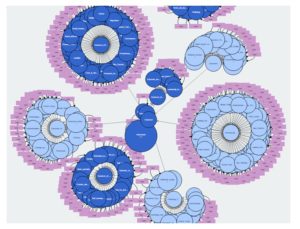
Fig 4: Cluster of Constructs belonging to a various fields of research: A diagram generated by the visualization tool of the software VOWL
The resulting ontology based repository consists of concepts and their relationship that are interlinked with each other. The repository is explored for gaps using a query tool called DL-Queries. The tool provides results depending upon the specified criteria representing user requirements. Specification of criteria and the selection of the outputs require skills for using the interface.
The query shown in Figure 5 is the result of exploring the variable “Satisfaction” in different effects. The variable was found in two different contexts; online shopping and work life balance. This variable “Satisfaction” affects other variables like “loyalty” and “intention”. This query helps us in the identification of a gap that there exists a “loyalty” variable which has been used in online shopping but has not been explored in the work-life balance. Hence, it can also be used in the research related to work-life balance.
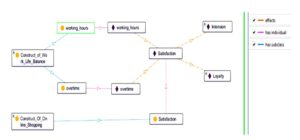
Fig 5: Result of querying the ontology based repository: Search for construct “Satisfaction” reveals its use in two different contexts
The example in Figure 6 shows a complex query which extracts those “Publications” which were published in Year 2013 and have used both the Constructs “Loyalty” and “Satisfaction”; The DL-Query is “(usedConstruct some Satisfaction and usedConstruct some Loyalty) OR (usedConstruct some working hours) and (Year value “2013” )”. The execution of the Query is shown in Figure 6. It shows that the publications meeting this requirement is only Publication7.

Fig 6: Use of a complex query with result
Simple Queries can also be used to retrieve information about Construct, Publication, Independent, Dependent, Instruments, and Authors etc. For instance, query “effects only Loyalty” is executed in the DL-Query Tab. All Individual constructs which affect the construct Loyalty are displayed. Fig 7 demonstrates this Query.

Fig 7: Use of a simple query
A user can also apply a complex query to narrow down results compared to simple queries. The complex query can often over burden the search engine when we try to search for all those individuals that effects Trust and also effect “Satisfaction”. Hence the query was modified to search for constructs that “effects some Perceived Quality and effects some Loyalty”. See Fig 8.
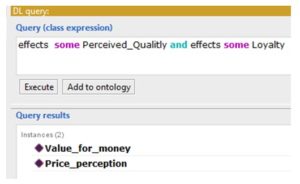
Fig 8: Examples of Complex Queries
Conclusions and Future Work
This study demonstrates that the ontology based repositories extensively being used in other research disciplines and applied fields can be usefully deployed in the area of business management research by integrating the conceptual frameworks built and tested in publications. Using the conceptual frameworks of 120 publications of quantitative research, we created an ontology consisting of 680 individuals representing 351 classes and 3431 relationships. The resulting ontology based repository of conceptual frameworks aids in systematic literature review in the field of business management for the identification of gaps and understanding the contribution to a given field. It helps in identifying gaps in the use of constructs and their relationships by revealing (i) relationships that have been tested in one research field but not in others, (ii) gaps of the usage of constructs and their relationships from one theory to another, and (iii) links between existing datasets, and (iv) links of business analytics with behavioral research through DL queries.4
Integrating conceptual frameworks obtained from existing research papers in a repository that may contain a huge collection of papers requires ontological representations and tools like Protégé. The effort is manual, tedious and requires both the domain expertise as well as tool expertise. The initial results presented in this paper indicate that ontological relationships existing in tools like Protégé need also to be extended to represent constructs such as moderating variables used in quantitative research.
The effort to use the built-in features of OWL is complex given the nature of research which requires integrating the effort and work of several researchers working in different fields of business management research. This paper was a collaborative effort of different researchers to integrate conceptual frameworks of their survey of literature from their fields of research that included online shopping, HR, Finance and Marketing, and organization development. This research indicates that there is a need for researchers in business management fields to use tools for ontology based knowledge representations and for capturing and collaborating with each other in integrating the results of their research.
(adsbygoogle = window.adsbygoogle || []).push({});
References
Anderson RE and Srinivasan SS. (2003) E‐satisfaction and e‐loyalty: A contingency framework. Psychology & marketing 20: 123-138.
Google Scholar
Antezana E, Kuiper M and Mironov V. (2009) Biological knowledge management: the emerging role of the Semantic Web technologies. Briefings in bioinformatics 10: 392-407.
Google Scholar
Bandrowski A, Brinkman R, Brochhausen M, et al. (2016) The ontology for biomedical investigations. PloS one 11: e0154556.
Belhajjame K and Brambilla M. (2009) Ontology-based description and discovery of business processes. Enterprise, Business-Process and Information Systems Modeling. Springer, 85-98.
Google Scholar
Bilder RM, Sabb FW, Parker DS, et al. (2009) Cognitive ontologies for neuropsychiatric phenomics research. Cognitive neuropsychiatry 14: 419-450.
Google Scholar
Damanpour F and Gopalakrishnan S. (2001) The dynamics of the adoption of product and process innovations in organizations. Journal of Management studies 38: 45-65.
Google Scholar
Grefenstette G and Rafes K. (2015) Transforming Wikipedia into an Ontology-based Information Retrieval Search Engine for Local Experts using a Third-Party Taxonomy. arXiv preprint arXiv:1511.01259.
Google Scholar
Hinkelmann K, Gerber A, Karagiannis D, et al. (2016) A new paradigm for the continuous alignment of business and IT: Combining enterprise architecture modelling and enterprise ontology. Computers in Industry 79: 77-86.
Google Scholar
Hwang I, Kim M and Ahn HJ. (2016) Data Pipeline for Generation and Recommendation of the IoT Rules Based on Open Text Data. Advanced Information Networking and Applications Workshops (WAINA), 2016 30th International Conference on. IEEE, 238-242.
Google Scholar
Iqbal R. (2012) Ontology development for Sufism domain. Fourth International Conference on Machine Vision (ICMV 11). International Society for Optics and Photonics, 834903-834903-834911.
Google Scholar
Jalees T, Shahid N and Tariq H. (2015) An Empirical Investigation on the Effect of Brand Loyalty. Journal of Management Sciences 2: 166-184.
Google Scholar
Kasnakoglu BT, Yilmaz C and Varnali K. (2016) An asymmetric configural model approach for understanding complainer emotions and loyalty. Journal of Business Research 69: 3659-3672.
Google Scholar
Khan MM. (2016) Factors of Consumer Choice of SmartPhones–A Study on Brand Image and Brand Features. Market Forces
Google Scholar
Khan SK and Jalees T. (2017) Antecedents to Brand Image. Market Forces
Kim J and Kang S. (2013) An ontology-based personalized target advertisement system on interactive TV. Multimedia tools and applications 64: 517-534.
Google Scholar
Le-Phuoc D, Quoc HNM, Quoc HN, et al. (2016) The Graph of Things: A step towards the Live Knowledge Graph of connected things. Web Semantics: Science, Services and Agents on the World Wide Web 37: 25-35.
Google Scholar
Liwen H and Min X. (2004) Research on modelling customer ontology under crm framework. PACIS 2004 Proceedings: 139.
Google Scholar
Mendes PN, Jakob M and Bizer C. (2012) DBpedia: A Multilingual Cross-domain Knowledge Base. Citeseer, 1813-1817.
Google Scholar
Mikhalenko P. (2003) The benefits of the Web ontology language in Web applications. Available at: http://www.techrepublic.com/article/the-benefits-of-the-web-ontology-language-in-web-applications/.
Mortimer G, Fazal e Hasan S, Andrews L, et al. (2016) Online grocery shopping: the impact of shopping frequency on perceived risk. The International Review of Retail, Distribution and Consumer Research 26: 202-223.
Google Scholar
Oberle D. (2014) How ontologies benefit enterprise applications. Semantic Web 5: 473-491.
Osterwalder A. (2004) The Business Model Ontology-a proposition in a design science approach.
Osterwalder A, Pigneur Y and Tucci CL. (2005) Clarifying business models: Origins, present, and future of the concept. Communications of the association for Information Systems 16: 1.
Google Scholar
Pappu R and Quester PG. (2016) How does brand innovativeness affect brand loyalty? European Journal of Marketing 50: 2-28.
Google Scholar
Pérez AG, López MF and Corcho O. (2004) Ontological engineering. Computer Sciences. Springer. London.
Rowe M and Ciravegna F. (2008) Getting to me–exporting semantic social network information from facebook. The 7th International Semantic Web Conference. Citeseer, 43.
Rubin DL, Lewis SE, Mungall CJ, et al. (2006) National center for biomedical ontology: advancing biomedicine through structured organization of scientific knowledge. Omics: a journal of integrative biology 10: 185-198.
Google Scholar
Soldatova LN and King RD. (2005) Are the current ontologies in biology good ontologies? Nature biotechnology 23: 1095-1098.
Srinivasan SS, Anderson R and Ponnavolu K. (2002) Customer loyalty in e-commerce: an exploration of its antecedents and consequences. Journal of retailing 78: 41-50.
Google Scholar
Turner JA and Laird AR. (2012) The cognitive paradigm ontology: design and application. Neuroinformatics 10: 57-66.
Vanteru BC, Shaik JS and Yeasin M. (2008) Semantically linking and browsing PubMed abstracts with gene ontology. BMC genomics 9: S10.
Google Scholar
Wand Y, Storey VC and Weber R. (1999) An ontological analysis of the relationship construct in conceptual modeling. ACM Transactions on Database Systems (TODS) 24: 494-528.
Google Scholar
Yadav U, Narula GS, Duhan N, et al. (2016) Development and Visualization of Domain Specific Ontology using Protege. Indian Journal of Science and Technology
Google Scholar
Yan Y and Zha X. (2010) Applying OWL to Build Ontology for Customer Knowledge Management. JCP 5: 1693-1699.
Google Scholar












